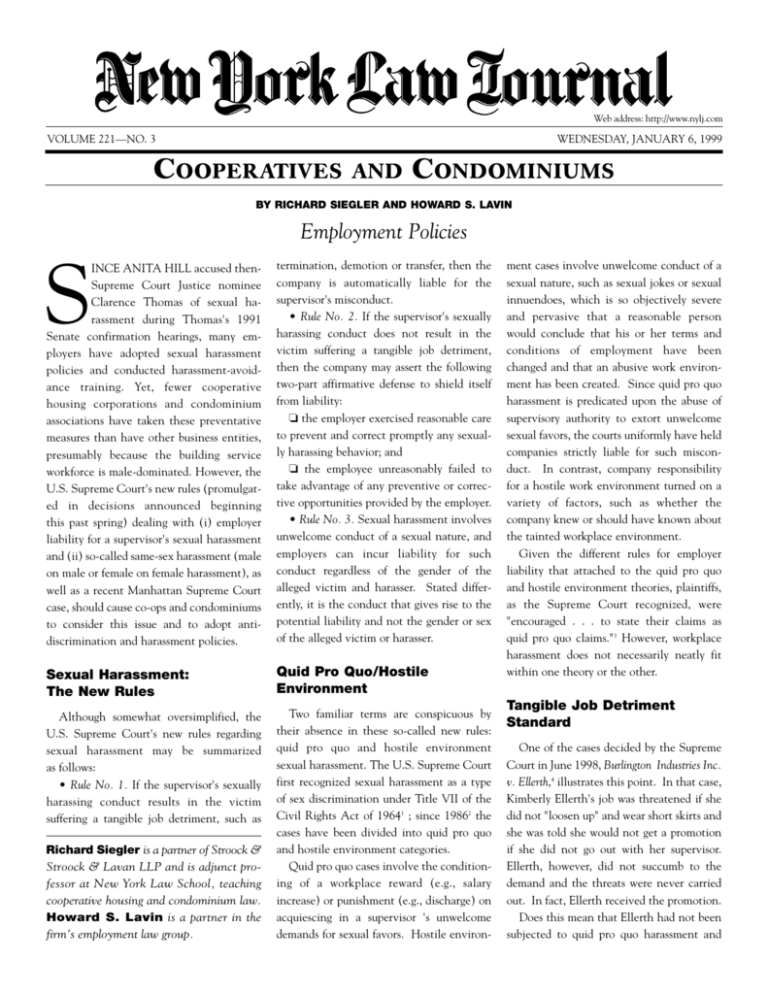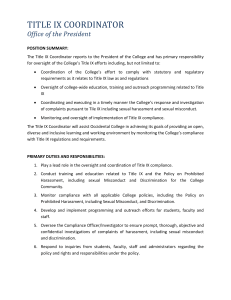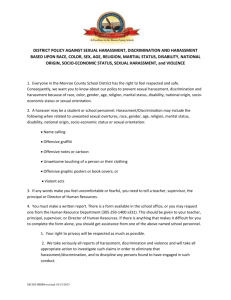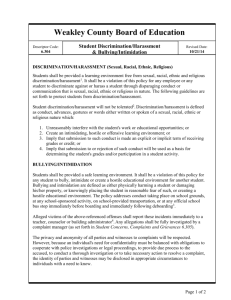
Web address: http://www.nylj.com
VOLUME 221—NO. 3
WEDNESDAY, JANUARY 6, 1999
C OOPERATIVES
AND
C ONDOMINIUMS
BY RICHARD SIEGLER AND HOWARD S. LAVIN
Employment Policies
INCE ANITA HILL accused thenSupreme Court Justice nominee
Clarence Thomas of sexual harassment during Thomas's 1991
Senate confirmation hearings, many employers have adopted sexual harassment
policies and conducted harassment-avoidance training. Yet, fewer cooperative
housing corporations and condominium
associations have taken these preventative
measures than have other business entities,
presumably because the building service
workforce is male-dominated. However, the
U.S. Supreme Court's new rules (promulgated in decisions announced beginning
this past spring) dealing with (i) employer
liability for a supervisor's sexual harassment
and (ii) so-called same-sex harassment (male
on male or female on female harassment), as
well as a recent Manhattan Supreme Court
case, should cause co-ops and condominiums
to consider this issue and to adopt antidiscrimination and harassment policies.
S
termination, demotion or transfer, then the
company is automatically liable for the
supervisor's misconduct.
• Rule No. 2. If the supervisor's sexually
harassing conduct does not result in the
victim suffering a tangible job detriment,
then the company may assert the following
two-part affirmative defense to shield itself
from liability:
❏ the employer exercised reasonable care
to prevent and correct promptly any sexually harassing behavior; and
❏ the employee unreasonably failed to
take advantage of any preventive or corrective opportunities provided by the employer.
• Rule No. 3. Sexual harassment involves
unwelcome conduct of a sexual nature, and
employers can incur liability for such
conduct regardless of the gender of the
alleged victim and harasser. Stated differently, it is the conduct that gives rise to the
potential liability and not the gender or sex
of the alleged victim or harasser.
Sexual Harassment:
The New Rules
Quid Pro Quo/Hostile
Environment
Although somewhat oversimplified, the
U.S. Supreme Court's new rules regarding
sexual harassment may be summarized
as follows:
• Rule No. 1. If the supervisor's sexually
harassing conduct results in the victim
suffering a tangible job detriment, such as
Two familiar terms are conspicuous by
their absence in these so-called new rules:
quid pro quo and hostile environment
sexual harassment. The U.S. Supreme Court
first recognized sexual harassment as a type
of sex discrimination under Title VII of the
Civil Rights Act of 19641 ; since 19862 the
cases have been divided into quid pro quo
and hostile environment categories.
Quid pro quo cases involve the conditioning of a workplace reward (e.g., salary
increase) or punishment (e.g., discharge) on
acquiescing in a supervisor 's unwelcome
demands for sexual favors. Hostile environ-
R
lr
g
ie
S
d
aichard Siegler is a partner of Stroock &
h
c
R
Stroock & Lavan LLP and is adjunct professor at New York Law School, teaching
cooperative housing and condominium law.
Howard S. Lavin is a partner in the
firm's employment law group.
ment cases involve unwelcome conduct of a
sexual nature, such as sexual jokes or sexual
innuendoes, which is so objectively severe
and pervasive that a reasonable person
would conclude that his or her terms and
conditions of employment have been
changed and that an abusive work environment has been created. Since quid pro quo
harassment is predicated upon the abuse of
supervisory authority to extort unwelcome
sexual favors, the courts uniformly have held
companies strictly liable for such misconduct. In contrast, company responsibility
for a hostile work environment turned on a
variety of factors, such as whether the
company knew or should have known about
the tainted workplace environment.
Given the different rules for employer
liability that attached to the quid pro quo
and hostile environment theories, plaintiffs,
as the Supreme Court recognized, were
"encouraged . . . to state their claims as
quid pro quo claims."3 However, workplace
harassment does not necessarily neatly fit
within one theory or the other.
Tangible Job Detriment
Standard
One of the cases decided by the Supreme
Court in June 1998, Burlington Industries Inc.
v. Ellerth,4 illustrates this point. In that case,
Kimberly Ellerth's job was threatened if she
did not "loosen up" and wear short skirts and
she was told she would not get a promotion
if she did not go out with her supervisor.
Ellerth, however, did not succumb to the
demand and the threats were never carried
out. In fact, Ellerth received the promotion.
Does this mean that Ellerth had not been
subjected to quid pro quo harassment and
NEW YORK LAW JOURNAL
that Burlington Industries should, thus,
escape strict liability? From a company
liability standpoint, this was a critical
question because Burlington Industries had
neither actual nor constructive knowledge of
the harassing conduct. And, under the
so-called "old rules," Burlington Industries
would avoid liability for the hostile work
environment created by its supervisor, since
it was not aware of the problem.
The Supreme Court's solution: move away
from the quid pro quo—hostile environment
labels with regard to the issue of employer
liability and instead focus on whether the
conduct involved a tangible job detriment.
WEDNESDAY, JANUARY 6, 1999
In one of the other recent Supreme Court
cases, Faragher v. City of Boca Raton,5 Beth
Faragher, a life guard, claimed that her supervisors repeatedly made uninvited, vulgar and
sexually offensive comments. Although the
City of Boca Raton had adopted a sexual
harassment policy in 1986, the City failed to
circulate the policy among the lifeguards.
Therefore, Faragher's supervisors and many of
the lifeguards were not even aware that the
policy or any complaint procedures existed.
The result: Since the City had failed to disseminate its sexual harassment policy or keep
track of its supervisors' conduct, the Supreme
Court ruled that the City of Boca Raton
could not assert the affirmative defense.
Two-Part Affirmative Defense
Again, if the supervisor's sexually
harassing conduct results in a tangible job
detriment, such as termination, demotion or
transfer, the company is automatically or
vicariously liable; if not, then the company
may assert the following two-part affirmative defense:
• the employer exercised reasonable
care to prevent and correct promptly any
sexually harassing behavior; and
• the employee-plaintiff unreasonably
failed to take advantage of any preventive
or corrective opportunities provided by
the employer.
The Court made plain that one virtually
indispensable element of the employer's
"reasonable care" affirmative defense is that
it had a suitable sexual harassment policy in
place at the time of the alleged harassment.
And the Court also stated that an employee's
unreasonable failure to use an established
complaint procedure would normally suffice
to show that the employee failed to take
advantage of opportunities provided by the
employer to avoid the harm.
What did this mean in the Burlington
Industries case?
The Supreme Court remanded the case to
the lower court to apply the two-part affirmative defense. Since Burlington Industries had
a sexual harassment complaint procedure and
Ellerth knew about it and failed to use it,
company liability will now turn on whether
her failure to use the policy was "reasonable."
Same-Sex Harassment
As noted at the outset, co-ops and
condominiums often have determined that
the risk of sexual harassment is minimal, at
best, because their workforces are male-dominated. In Oncale v. Sundowner Offshore Services,6 however, the U.S. Supreme Court permitted employees to bring same-sex sexual
harassment claims. In that case, the lower
courts dismissed Joseph Oncale's claim
because all of the alleged harassers on his
offshore oil rig —like Oncale—were male.
On appeal, the High Court reversed, reasoning that it is the pervasive unwelcome conduct of a sexual nature that results in a viable
claim for sexual harassment and not the
gender of the alleged victim and harasser.
In reaching its decision, the Court
cautioned that Title VII and analogous state
and local anti-discrimination laws are not
general civility codes for the workplace; that
is, horseplay and cursing do not, in and of
themselves, constitute unlawful harassment.
Rather, hostile environment sexual harassment arises only where the unwelcome
conduct of a sexual nature is so objectively
offensive that a reasonable person would
find that a hostile working environment had
been created.
'Failure to Hire'
The Equal Employment Opportunity
Commission has previously raised questions
about the hiring practices at Manhattan
apartment buildings, focusing on why persons holding concierge and door positions
were overwhelmingly male and white.
Furthermore, in October 1998, a Manhattan
Supreme Court denied a motion for summary judgment filed by 13 co-ops in a "failure to
hire" discrimination case.
In Hill v. Douglas Elliman,7 the plaintiff, a
black female, alleged that she was not hired
as a door person by any one of 13 buildings
that Douglas Elliman managed because of
her race and gender in violation of applicable anti-discrimination laws. The defendant
co-ops moved for summary judgment asserting that Douglas Elliman merely accepted
employment applications to be maintained
for access by these buildings but did not have
authority to engage in any discriminatory
conduct. The court denied the motion.
The court noted that none of the
defendants had explained why the plaintiff
was not selected for numerous door person
positions. Instead the defendants "pointed
the finger at each other" and raised various
"technical legal theories" to escape liability.
The outcome of this case is uncertain.
Recommendations
Now that the Supreme Court has
road-mapped the legal framework to be used
in sexual harassment cases, what does it
mean for employers? In broad terms, it
means that it will be easier for employees to
sue for sexual harassment because companies
may be held liable for a supervisor's hostile
environment harassment even though the
company was not aware of the problem.
However, the guidelines provided by the
Supreme Court provide insight into what
steps an employer can take to avoid liability
for non-job detriment sexual harassment—
steps that are discussed below.
Some in the residential management
community have questioned the wisdom of
implementing anti-discrimination policies
and complaint procedures, reasoning that (i)
to date, relatively few discrimination claims
have been asserted, (ii) such policies and
procedures may "red-flag" the issue and result
in more discrimination claims being made,
NEW YORK LAW JOURNAL
and (iii) discrimination claims are expressly
subject to the grievance and arbitration
procedures in the 1997 Apartment Building
Agreement between Realty Advisory Board
on Labor Relations Incorporated and Local
32B-32J Service Employees International
Union, AFL-CIO. This is not necessarily
the case.
First, it is unsettled whether a union-negotiated explicit waiver of union employees'
statutory rights to pursue employment discrimination claims in court is enforceable. In
Wright v. Universal Maritime Service Corp.,8
the Supreme Court recently ruled that
a broad general arbitration clause in a
collective bargaining agreement did not
waive an employee's right to a judicial forum
for his federal disability discrimination claim.
Although the Supreme Court in Wright
had the opportunity, it decided (i) not to
address the inherent tension between two
lines of Supreme Court precedent9 and (ii)
not to decide whether a clear and unmistakable union-negotiated waiver of union
employees' rights to a judicial forum for
federal employment discrimination claims
could be enforceable.10
Second, compulsory arbitration is merely
a forum selection mechanism. Therefore,
even if union employees are required to
arbitrate (and not litigate in court) their
discrimination claims, an arbitrator hearing
an employment discrimination matter would
almost certainly apply relevant caselaw,
including the Supreme Court-created, twopart affirmative defense. Stated differently,
internal anti-discrimination policies and
complaint procedures and labor arbitrations
are not mutually exclusive. This is especially
where, as with the policies and complaint
procedures that we have drafted for our
building service clients, the corporation
recognizes that certain employees are subject
to union contracts.
Third, non-union employees and certain
unionized workers whose union contracts do
not seek to require arbitration of discrimination claims are free to pursue such claims in
court. And, of course, rejected job applicants
also may litigate alleged discriminatory
failure-to-hire claims in court.
WEDNESDAY, JANUARY 6, 1999
Fourth, the frequency with which allegations of discrimination have appeared in
recent years in the media, including on
television and in the movies, already has
sensitized workers to these issues. Moreover,
the U.S. Supreme Court's new rules regarding sexual harassment and the Douglas
Elliman case, together, effectively mean that
co-op and condominium entities are at risk
for employment discrimination claims just
like any other employer. Therefore, it is
recommended that co-ops and condominiums should:
• Promulgate a written anti-harassment
and anti-discrimination policy, which
includes, among other things, a clear statement prohibiting such conduct, including
sexual harassment, examples of prohibited
conduct and a user-friendly, clearly defined
complaint procedure;
• Ensure that the employees understand
the policy and that they should report the
offending conduct, even if it is engaged in
by supervisory personnel or non-employees, such as vendors who do business with
the building. In this regard, employees
must be provided options as to whom they
may make a complaint. For example, the
complaint-takers could be the building
manager, the account executive for the
managing agent, president of the co-op
and any board member with whom the
employee is comfortable.
• If the co-op or condominium already
has a policy, review it to make sure it is still
in compliance and helps to get employees
to bring these matters to the attention of
appropriate company personnel for prompt
corrective action, if appropriate. For example, does the policy provide a complaint
mechanism for dealing with alleged race
discrimination or harassment? Why is this
important? The short answer is because two
of the 11 U.S. Circuit Courts of Appeal
have already dealt with this issue and have
applied the Supreme Court's sexual harassment standard to a race harassment claim11;
• Distribute the policy to the entire
workforce;
• Promptly respond to complaints
brought under the policy and take prompt,
appropriate corrective action to remedy the
harassing behavior and to help prevent a
recurrence; and
• Periodically conduct mandatory
anti-harassment and discrimination prevention training for all employees. In addition,
complaint-takers must be trained about how
to deal with these issues, including how to
investigate alleged violations.
Conclusion
Based on the emerging case law discussed
above, co-ops and condominiums should
take steps to protect themselves from
harassment and discrimination claims.
The adoption of an employment policy,
with an appropriate training program for
building staff and supervisors, should help
to avoid these claims and the attendant
legal costs.
••••••••••••••
•••••••••••••••••
(1) 42 USC §2000(e).
(2) Vinson v. Merritor Savings Bank, 106 S.Ct. 2399
(1986).
(3) Burlington Industries Inc. v. Ellerth, 118 S.Ct.
2257, 2259 (1998).
(4 )118 S.Ct. 2257 (1998).
(5) Faragher v. City of Boca Raton, 118 S.Ct. 2275
(1998).
(6) Oncale v. Sundowner Offshore Services, 118 S.Ct.
998 (1998).
(7) Hill v. Douglas Elliman, New York Law Jouranl,
Oct. 16, 1998, p. 28, col.3 (Sup. Ct. NY Cty).
(8) Wright v. Universal Maritime Service Corp., 119
S.Ct. 391 (1998).
(9) Compare Gilmer v. Interstate/Johnson Lane Corp.,
111 S.Ct. 1647 (1991) (where the Supreme Court ruled
that an age discrimination claim was subject to compulsory arbitration pursuant to arbitration provisions in
the securities industry registration agreement) with
Alexander v. Gardner-Denver Co., 94 S.Ct. 1011 (1974)
(where the Supreme Court permitted an individual's
race discrimination suit to proceed even though he had
previously unsuccessfully raised the discrimination
claim in an arbitration brought pursuant to his union 's
grievance and arbitration procedure).
(10) Wright, 119 S.Ct. 391, 394 and 396 (where the
Supreme Court acknowledged the tension between the
Gilmer and Gardner-Denver lines of authority and
inquired (but did not answer) whether Gardner-Denver's seemingly absolute prohibition of a union's waiver
of employees' federal forum rights survives Gilmer.
(11) Deffenbaugh Williams v. Wal-Mart StoresInc. 156
F3d 581 (5th Cir. 1998); Wright-Simmons v. City of
Oklahoma City, 155 F3d 1264 (10th Cir. 1998).
This article is reprinted with permission from the
January 6, 1999 edition of the NEW YORK LAW
JOURNAL. © 1999 NLP IP Company. All rights
reserved. Further duplication without permission is
prohibited. For information contact, American
Lawyer Media, Reprint Department at 800-888-8300
x6111. #070-01-04-0021








